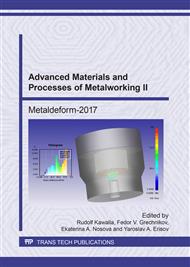[1]
D.S. Kong, L.H. Lang, Z.Y. Sun et al, Hydroforming Process of Aluminum Alloy Thin-wall Corrugated Sheet. Journal of Netshape Forming Engineering, 7(3)(2015) 62-66.
Google Scholar
[2]
Z.Y. Sun, L.H. Lang, D.S. Kong, Simulation Analysis of Hydroforming Process for Aluminum Alloy Saddle Parts, Journal of Netshape Forming Engineering, 7(1)(2015) 46-50.
Google Scholar
[3]
L.H. Lang, N. Xu, Y.M. Wang, et al, Research on Failure Control of Hydroforming for 321 Stainless Steel V-shaped Components, Forming & Stamping Technology, 37(5)(2012) 51-55.
Google Scholar
[4]
H.J. Becker, G. Bensman, Further Development in Hydromechanical Deep Drawing, Developments in the Drawing of Metals on Metal Society, London , (1983).
Google Scholar
[5]
K. Nakamura, T. Nakagawa., Sheet Metal Forming with Hydraulic Counter Pressure in Japan, Annal CIRP, 36(1987) 191-194.
DOI: 10.1016/s0007-8506(07)62583-9
Google Scholar
[6]
L.H. Lang, S.T. Zhang, T Li, et al, Investigation into the Forming of Complicated Parts with Poor Formability Materials in Cold/Warm Sheet Hydroforming, Tube Hydroforming Technology, Minemachi, (2007).
Google Scholar
[7]
L.H. Lang, J. Dancker, K.B. Nielsen., Study on Hydromechanical Deep Drawing with Uniform Pressure onto the Blank, International Journal of Machine Tools & Manufacture, 44(2004) 495-502.
DOI: 10.1016/j.ijmachtools.2003.10.028
Google Scholar
[8]
Q.Y. Li, S.M. Nie, J.L. Tang, et al, Research on Hydroforming of Square Parabolic Reflector, Forming & Stamping Technology, 33(4)(2005) 12-14.
Google Scholar
[9]
H.J. Liu, L.H. Lang, Investigation on Warm /Hot Hydro-forming of High Strength Aluminum Alloy Sheet, Journal of Plasticity Engineering, 16(1)(2009) 32-36.
Google Scholar
[10]
Y. Yang, S.F. Sun, H.R. Liu, Hydroforming Technology of Complex Profile Cover Sheet of Aeroengine, Aeronautical Manufacturing Technology, 1(1)(2010) 91-99.
Google Scholar
[11]
H.Y. Xiang, C.J. Leng, Y. Zhang, Case Analysis of Numerical Simulation for Automobile Panel Forming Defects, Computer Simulation, 26(12)(2009) 226-229.
Google Scholar
[12]
L.H. Lang, Innovative Sheet Hydroforming and Warm/Hot Hydroforming, National Defense Industry Press, (2014).
Google Scholar
[13]
C.H. Hartl., Research and advances in fundamentals and industrial applications of hydroforming, Journal of Materials Processing Technology, 167(2-3)(2005) 383-392.
DOI: 10.1016/j.jmatprotec.2005.06.035
Google Scholar
[14]
K. Siegert, M. Haussermann, B. Losch, et al, Recent development in hydroforming technology, Journal of Materials Processing Technology, 98(2)(2000) 251-258.
Google Scholar
[15]
J.C. Gelin, O. Ghouati, P. Paquir., Modelling and control of hydroforming process for flanges forming, Annals of CLRP, Swizerland: Hallwag, 47(1)(1998) 213-216.
DOI: 10.1016/s0007-8506(07)62820-0
Google Scholar
[16]
J.L. Tang, Upper-bound chamber pressure in hydraulic counter-pressure deep drawing of conical part, Chinese Journal of Mechanical Engineering, 38(2)(2002) 131-133.
DOI: 10.3901/jme.2002.02.131
Google Scholar
[17]
L.H. Lang, N. Xu, Research on hydroforming technology for rectangular box with deep cavity, Forging & Stamping Technology, 38(2)(2013) 21-25.
Google Scholar
[18]
D.L. Mcdowell., Modelling and Experiments in Plasticity, International Journal of Solids and Structures, 37(1-2)(2000) 293-309.
Google Scholar


